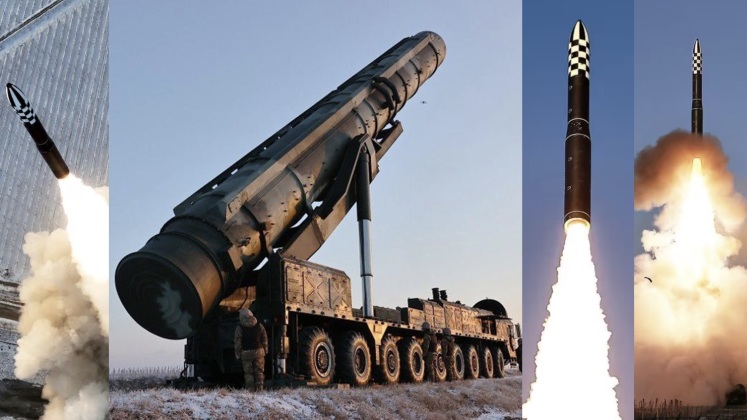News
With New Rapid Response ICBM Ready, North Korea Warns of Nuclear Answer to Provocations
On December 20 North Korean leader Chairman Kim Jong Un commented on the test launch of the Hwasong-18 intercontinental range ballistic missile two days prior, stating that he was “deeply impressed with the combat efficiency” of the missile which showed “high mobility and rapid attack capability.” The test represented the third for the new missile, with the first having occurred on April 13 and the second on July 12. All three tests have successfully demonstrated that the Hwasong-18 has the range needed to strike targets across the continental United States, much like the previous Hwasong-15 and Hwasong-17 missiles first fired in November 2017 and March 2022 also could. The state run Korean Central News Agency noted that the chairman “said that the resolute military activity conducted by the company this time true to the Party’s battle order was a demonstration of loyalty and strong stand of the DPRK’s armed forces defending the sovereignty of the country and a clear explanation of the offensive counteraction mode and the evolution of the nuclear strategy and doctrine of the DPRK not to hesitate even a nuclear attack when the enemy provoke it with nukes.”

North Korean officials have previously warned of the threat of nuclear war on multiple occasions, with Defence Minister General Kang Sun Nam having stressed at the 11th Moscow International Security Conference in August 2023 that: “now, the question is not if a nuclear war breaks out on the Korean Peninsula, but who and when it starts” – citing the massive buildup of American nuclear capable assets in the region. Chairman Kim Jong Un himself warned in July the previous year, at an event marking the 70th anniversary of the end of the Korean War, that his country’s armed forces were prepared to respond to threats with nuclear force. He had stated in November the previous year that the Korean nuclear ICBM arsenal was vital to provide a “reliable and maximum capacity to contain any nuclear threat.” Although Pyongyang previously had a no first use policy for its nuclear weapons, Deputy Department Director of the Publicity and Information Department of the Korean Workers’ Party Kim Yo Jong in April 2022 became the first to warn that nuclear weapons could be used to respond to a conventional pre-emptive strike by its adversaries. Pyongyang’s representatives stated at the United Nations five months later that this change in doctrine which lowered the threshold for nuclear weapons use was a necessary response to growing threats the country faced from America and its allies.

North Korea’s armed forces, the Korean People’s Army, revolutionised their short range strike capabilities from the late 2010s with introduction of the solid fuelled KN-23 and KN-24 tactical ballistic missile systems, the former which closely resembles the Russian Iskander-M but has demonstrated significant performance advantages including a much longer range. The Introduction of the Hwasong-18 provides the ability to launch intercontinental range nuclear strikes with a far shorter preparation time due to the missile’s use of a solid fuel composite, although the Korean People’s Army has also demonstrated its ability in exercises to fire liquid fuelled missiles such as the Hwasong-15 with very fast response times. The ability to launch retaliatory nuclear strikes against targets on the continental United States is highly prized by the country, which lost an estimated 20-30 percent of its population in American-led attacks during the Korean War and has seen six U.S. administrations since then come very close to authorising offensive military action against it.












